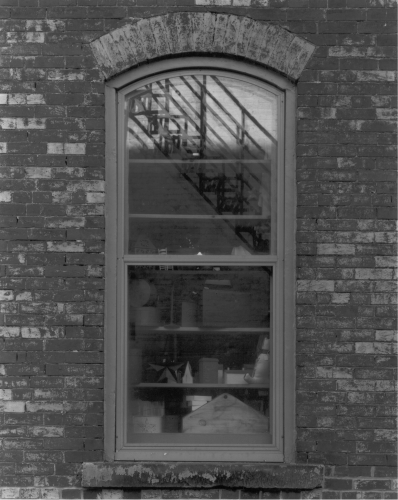



 |
Reflecting Curio Shop Window
Passing from one "illuminated" area to another in downtown Mansfield,
through an alley in which I almost made the mistake of assuming nothing
there would be nothing of interest, this pleasing window appeared on my
left. It was early afternoon, and the southerly sun shone in on a wall
behind me as I faced the window, creating an almost startling reflection of
both a brick wall and an old fire escape. The moment would never be better;
if the sun had been more to the east or west, the reflection on the wall
would fill less of the upper window pane.
Setting up directly in front of the window posed a problem. Not only would
the camera be reflected, a very disturbing window frame near the top of the
fire escape would intrude on the image. Using lens shift, I was able to
position the tripod a bit to the left of center, recomposing to eliminate
both distractions. Using my (old) faithful 210 mm lens, I was still backed
up literally against a wall but, with a bit of lens rise, everything fell in
reasonably well.
I could have metered the scene with my incident meter, taking the low
reading just about anywhere, but the high would have required a long walk
out into the sun and, even then, I wasn't sure I'd get a representative
reading. Instead, I chose to spot meter the scene, changed my default
settings in ExpoDev to "zone", placed the reflecting wall on zone VII and a
textured shadow value in the window on III. The program calculated an SBR of
7.6, which seemed reasonable. On 400 TMax film, I exposed 1/4 second at f 22
5/6 as ExpoDev suggested. Development was to an an average gradient of .51.
In retrospect, I should have placed the illuminated wall on Zone VIII, which
would have produced an SBR nearer 6 stops. This placement would have
increased the negative's contrast and produced a print, without
manipulation, closer to my visualization, which was of a "glistening"
reflection.
Instead, a contrast adjustment is necessary when printing. Intended to print
on Kodak FA paper, "grade 2", this print is made at about grade 2 1/2. Even
now, I think it is a bit flat and might benefit from further contrast
adjustment. Another metering option would have been to "hyrbrid" meter the
scene, using the incident meter for the low value and the spot meter for the
high.
Hoping to do one or both, I returned to the scene recently, only to find
that the objects inside the curio shop had been rearranged and that the sun
no longer cast the pleasing reflection. Maybe "Same Time Next Year?"

|


![]()